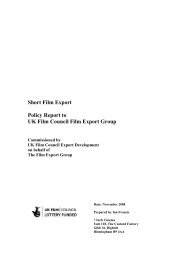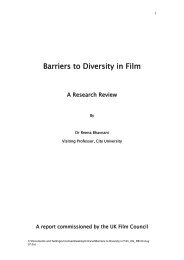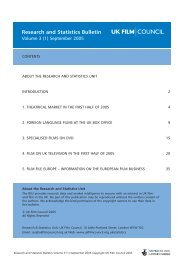Crossing Boundaries - BFI - British Film Institute
Crossing Boundaries - BFI - British Film Institute
Crossing Boundaries - BFI - British Film Institute
Create successful ePaper yourself
Turn your PDF publications into a flip-book with our unique Google optimized e-Paper software.
- Digitalisation has increased (potential) access to minority media: the venues are no longer the only providers of<br />
accessible minority media, although arguably they are the only providers of the ‘minority cinema experience’. In<br />
addition, the programmes of mainstream ‘multiplex’ cinemas do overlap with the venue programmes. In some cases,<br />
such as where larger cinema operators are located in city centres where there is a significant ‘knowledge worker<br />
footfall’, this overlap is increasing. In such cases, the cinema experience can be the determinant of choice.<br />
- The main audiences for the venues are under-representative of the city’s black and minority ethnic (BAME)<br />
demographic profile. In some cases, as with Watershed, the per cent proportion of the audience that is from BAME<br />
backgrounds match that of the per cent proportion of BAMEs across the city; but this is not to say that every BAME<br />
community is engaged. There are many instances of excellent programming that have attracted large mixed<br />
audiences, but such audiences are not representative of the core audience for the venues. This has implications for<br />
the ownership of the programming and the wider offer of the venues. That the venues are interpreted by some as<br />
being ‘cliquey’; ‘open for some and closed for others’, presents a significant challenge to the legitimacy and integrity<br />
of the venues.<br />
Doubtless, the venues undertake considerable outreach and education work and they do programme with audience development<br />
an absolutely central concern. They are working on their openness. Mother and baby mornings; minority programming; and myriad<br />
community projects exemplify this. However, capacity here has been limited and initiatives such as mother and baby mornings<br />
have in some cases stalled because licences have not been granted for babies to be present at films certificated for an older<br />
audience. However, a key challenge here is the rather out-moded notion of ‘audience’ and an inflexible methodology for engaging<br />
with said audience. The venues have actively fund-raised to conduct audience research, but in most cases a standard approach has<br />
been adopted that quantifies how services can be improved. Little work has been done on how the public understand them 17 , how<br />
the venues understand the public, and thus how new types of ownership can be invigorated. In addition, little research has been<br />
undertaken that explores how the wider offer of the venues – across their physical and digital footprints – can engender new types<br />
17 Watershed’s 2007 audience research found a lack of awareness about the breadth of programme.<br />
Introduction 50<br />
tom fleming / creative consultancy<br />
UK <strong>Film</strong> Council<br />
in association with<br />
Arts Council England and the Arts Humanities Research Council

















